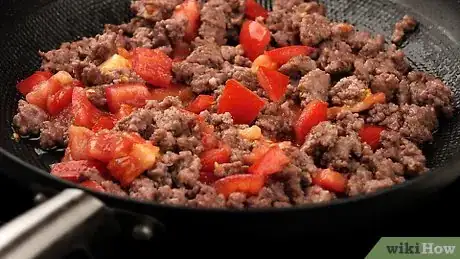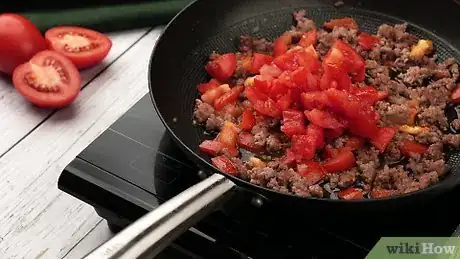This article was co-authored by Tara Coleman. Tara Coleman is a Clinical Nutritionist who has a private practice in San Diego, California. With over 15 years of experience, Tara specializes in sports nutrition, body confidence, and immune system health and offers personalized nutrition, corporate wellness, and online learning courses. She received a BS in Biology from James Madison University and spent six years in the pharmaceutical industry as an analytical chemist before founding her practice. Tara has been featured on NBC, CBS, Fox, ESPN, and Dr. Oz The Good Life as well as in Forbes, Cosmopolitan, Self, and Runner’s World.
There are 8 references cited in this article, which can be found at the bottom of the page.
wikiHow marks an article as reader-approved once it receives enough positive feedback. In this case, 98% of readers who voted found the article helpful, earning it our reader-approved status.
This article has been viewed 412,539 times.
Tomatoes can add wonderful flavor and nutrition to your favorite recipes. Tomatoes are very acidic, so they can cause serious problems for those with ulcers or other acid related digestive issues. You can reduce the acidity of tomatoes by adding some baking soda after you cook them. You can also remove the seeds, reduce the time you cook tomatoes, or add them to a dish raw.
Steps
Using Baking Soda
-
1Cut the tomatoes into pieces and simmer them at medium heat for about 10 minutes. If you are going to add the tomatoes into another hot dish, you may not need to cook them for as long. If you cut bigger chunks, you may need to cook them a little longer.[1]
- Be sure to watch the tomatoes carefully so that you can remove them from heat if they start to burn or become too crispy.
-
2Remove the pan from the burner and stir in 1/4 tsp of baking soda. This amount works well for six medium tomatoes, so for more or less tomatoes you can adjust the amount of baking soda.[2] Stir the baking soda so that all the pieces of tomato get a slight coating.[3]
- The baking soda will fizz as it reacts with the acid of the tomatoes.
Advertisement -
3Add the rest of your ingredients and finish cooking the dish. Once the fizzing has stopped, which may take a minute or so, finish cooking the dish. The baking soda will reduce the overall acid content of the dish and does not usually alter the taste of the dish.[4]
Deseeding and Shortening Cook Times
-
1Remove the seeds from the tomato. Carefully slice the tomato in half around what would be the equator line so that one half has the stem and one half has the bottom. Then use a ¼ teaspoon, or another small spoon, and scoop the tomato seeds out and discard them. Don’t scrape too deeply into the flesh of the tomato.[5]
- The seeds carry much of the acid content of the tomato plant, so removing them altogether is a great way to reduce the acidity.
- Some dishes are enhanced by cooking the seeds along with the flesh of the tomato, so take this into account before you remove the seeds.
-
2Reduce the cooking time of tomatoes. Tomatoes become more acidic as they cook longer, so reducing the cook time to the least amount possible can help keep the acid level lower. Sauces and other dishes that require long simmering may make this difficult, but it is recommended that you don’t cook tomatoes for longer than 1 ½ hours.
- You may have to get used to using tomatoes that are less cooked, but if you deal with problems stemming from acidic foods it may be worth the effort.
-
3Add tomatoes last. If you dish includes tomatoes, but tomatoes are not the main ingredient, add them after everything else has cooked for the majority of the necessary time. Doing this is another way of reducing the cook time, while still cooking them briefly.
- If a dish calls for you to simmer the ingredients for one hour, put the tomatoes in for the last 10 minutes. They’ll have time to warm up and soak into the dish a little bit, but not become overly acidic.
-
4Use raw tomatoes in the dish. In the same way that reducing the cooking time can reduce the acid content, foregoing cooking the tomatoes altogether will reduce the acidity. Raw tomatoes are far less acidic than cooked tomatoes. If you can include the tomatoes in the dish raw without significantly affecting the dish, this will make them less acidic.[6]
- If you are putting the tomatoes into a hot dish, the other ingredients will most likely heat the tomatoes up enough to even out the temperature of the dish.
Choosing Tomatoes to Use
-
1Look for the ripest tomatoes. Tomatoes lose some of their acidity as they ripen, so avoid tomatoes that appear to be less that fully ripe. Two good ways to check the ripeness of a tomato is to feel the weight and gently squeeze the tomato. Choose heavier tomatoes and softer tomatoes.[7] [8]
- Heavier means more juice, which means more ripe. Tomatoes that are soft but not mushy are more ripe than hard tomatoes.
- You can also learn the smell of a ripe tomato versus the smell of an unripe tomato.
-
2Cook with fresh tomatoes. The process of canning tomatoes ends up increasing the acidity, so you can reduce acid in your dishes by only cooking with fresh tomatoes. You’ll have to buy fresh tomatoes more frequently than canned ones as they will not last as long.[9]
-
3Choose non-red tomatoes. Tomatoes come in red, green, yellow, orange, and combinations of these, and in most cases non-red varieties of tomatoes are said to be lower in acidity. The next time you make your favorite tomato dish, try out some non-red tomatoes and see if you notice a difference in the acidity.[10]
- This is not a hard and fast rule as there are red varieties that are low-acid and non-red varieties that are high-acid.
- Some varieties to keep an eye out for are Yellow pear, a tomato similar to cherry varieties, Georgia Streak, a yellow heirloom variety, and Big Rainbow, a golden-red tomato.
Expert Q&A
-
QuestionWhat kills the acid in tomato sauce?
 Tara ColemanTara Coleman is a Clinical Nutritionist who has a private practice in San Diego, California. With over 15 years of experience, Tara specializes in sports nutrition, body confidence, and immune system health and offers personalized nutrition, corporate wellness, and online learning courses. She received a BS in Biology from James Madison University and spent six years in the pharmaceutical industry as an analytical chemist before founding her practice. Tara has been featured on NBC, CBS, Fox, ESPN, and Dr. Oz The Good Life as well as in Forbes, Cosmopolitan, Self, and Runner’s World.
Tara ColemanTara Coleman is a Clinical Nutritionist who has a private practice in San Diego, California. With over 15 years of experience, Tara specializes in sports nutrition, body confidence, and immune system health and offers personalized nutrition, corporate wellness, and online learning courses. She received a BS in Biology from James Madison University and spent six years in the pharmaceutical industry as an analytical chemist before founding her practice. Tara has been featured on NBC, CBS, Fox, ESPN, and Dr. Oz The Good Life as well as in Forbes, Cosmopolitan, Self, and Runner’s World.
Clinical Nutritionist You have two really good options for this. The first is to add some baking powder to your sauce. The other solution would be to use riper tomatoes for your sauce. The more ripe a tomato is, the less acidic it will be.
You have two really good options for this. The first is to add some baking powder to your sauce. The other solution would be to use riper tomatoes for your sauce. The more ripe a tomato is, the less acidic it will be.
References
- ↑ http://www.healthy-eating-support.org/Recipe-and-Cooking-Tips.html
- ↑ Tara Coleman. Clinical Nutritionist. Expert Interview. 22 October 2020.
- ↑ https://www.thekitchn.com/recipe-rescue-what-to-do-when-131736
- ↑ Tara Coleman. Clinical Nutritionist. Expert Interview. 22 October 2020.
- ↑ http://toriavey.com/how-to/2012/06/how-to-seed-tomatoes/
- ↑ http://www.onegreenplanet.org/natural-health/naturally-acidic-plant-based-foods-that-alkalize-the-body/
- ↑ http://www.veggiegardener.com/four-ways-to-know-a-tomato-is-ripe/
- ↑ Tara Coleman. Clinical Nutritionist. Expert Interview. 22 October 2020.
- ↑ http://whfoods.org/genpage.php?tname=dailytip&dbid=383
About This Article
To reduce acidity in tomato dishes, try adding 1/4 teaspoon of baking soda to the pan after you've cooked your tomatoes for 10 minutes. Then, wait until the tomatoes stop fizzing, which is a sign that the baking soda is reacting to the acid, before adding the rest of your ingredients. Alternatively, you can cut the tomatoes in half and scoop out the seeds before cooking them, since the seeds contain most of the acid. You could also try reducing the cook time for your tomatoes, as they get more acidic the longer they cook. For tips on how to buy tomatoes with lower levels of acidity, read on!
























































